Disclaimer: Timeusb sent this product to us for free for a review. That does not affect our opinion about the product. In this article, we list both what we like and dislike. Read more about this here.
What Kind Of Battery Charger Should I Use For A Lithium Battery?
Lithium batteries are amazing, especially for RVers and van dwellers. But one issue new lithium battery owners have to face is, how do I charge this thing?
If you’ve just installed a 12 volt lithium battery in your RV, you are going to need to make sure the RV’s power center has a lithium battery compatible charger inside.
Unless it’s a very new RV made specifically for lithium batteries, the odds are it’s not.
Related Product: Want to turn your 12 volt battery into a charging station? Check out this battery DC USB Hub by Timeusb (click to view on Amazon)
If you aren’t able to change the built-in battery charger in your RV or you don’t have that kind of setup, you can use an external lithium battery charger to keep your lithium batteries full when you’re near a power source.
If you use this method, make sure you disconnect the built-in RV charger from the battery.
To charge correctly, lithium batteries require a higher voltage than standard batteries to fully charge.
You’re going to need a smart charger with a lithium battery setting, or a charger like the Timeusb that’s made specifically for LiFePO4 batteries.
See Also: Timeusb 12V/24V Battery DC USB Hub Full Review & Test
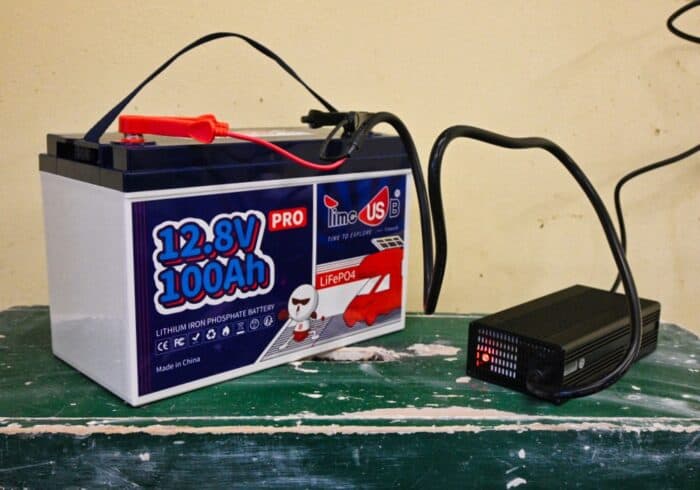
For most large 12V lithium-ion batteries, it’s recommended to use a charger that’s capable of a 20 to 50 amp current.
A 20 amp charger should be able to fully charge a 100 ah LiFePO4 battery in about 5 hours. The lower the charge current (amperage), the slower the battery will charge.
I have a few 100 ah lithium batteries right now. I’ve been using a 5 amp smart charger with a lithium mode to keep them charged, but it takes a long time and the charger can get pretty warm.
I was happy to try out and review this 20 amp lithium battery charger by Timeusb.
It works so much faster than my small smart charger, and so far it’s been able to charge all of my lithium batteries.
See Also: Timeusb 12V 100Ah LiFePO4 Pro Battery Tested & Reviewed
Timeusb 20 Amp Lithium Battery Charger
Features
- Fast Charging
- 20 Amp Charge Current
- 14.6 Volts
- Pre-Charging Mode
- Used to charge dead or dormant lithium batteries.
- Fast Charge Stage
- High charge current as voltage slowly increases.
- Float Charge Stage
- Voltage peaks as charge current drops.
- LED Indicator Light
- Green – Fully Charged
- Red – Charging
- Red Flashing – Protection Mode/Not Charging
- Charge Protection
- Over Temperature
- Short-Ciruit
- Reverse Polarity
- Over-Voltage
- Alligator Clamps (45 inch cable)
- 45 inch Power Cable
- Small Size (8 x 4 x 2 inches)
- Aluminum Shell
- Lightweight
- ETL Listed
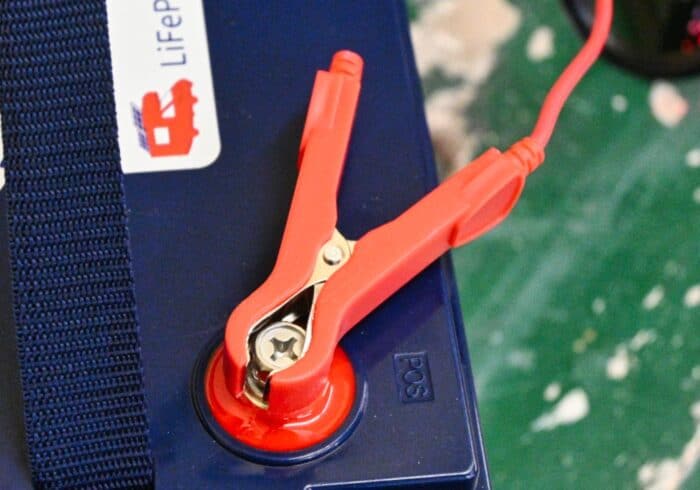
What’s in the Box?
- Timeusb 20 Amp LiFePO4 Charger
- Alligator Battery Clamps
- Power Cable
- User Manual
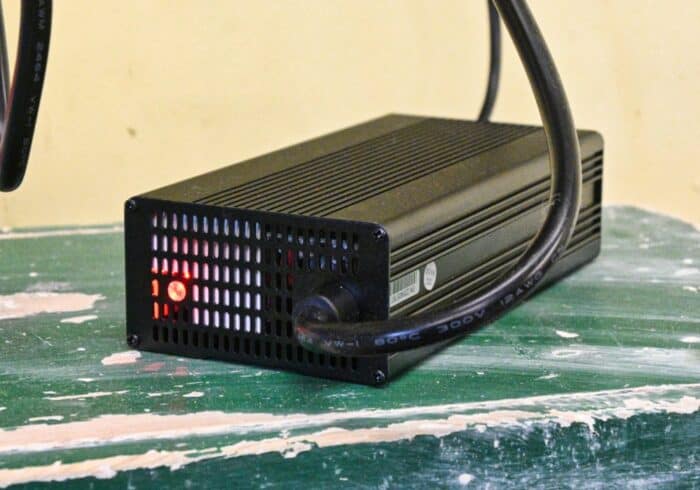
Lithium Battery Charging Test
Right now, I have 3 different brands of 100 amp hour lithium batteries, and I’ve been using the Timeusb 20 amp LiFePO4 battery charger on all of them.
One thing I’ve noticed is the fan inside the Timeusb is pretty loud, but that could be considered a good thing because heat can damage a battery charger.
So a good fan is a must have, especially for a high current fast charger. The aluminum case feels warm to the touch after a couple hours of charging, but it never gets hot.
My RV lithium batteries are recommended to be charged with a voltage between 14.2 and 14.6.
See Also: How To Install Solar Panel On RV Roof & Connect To Battery
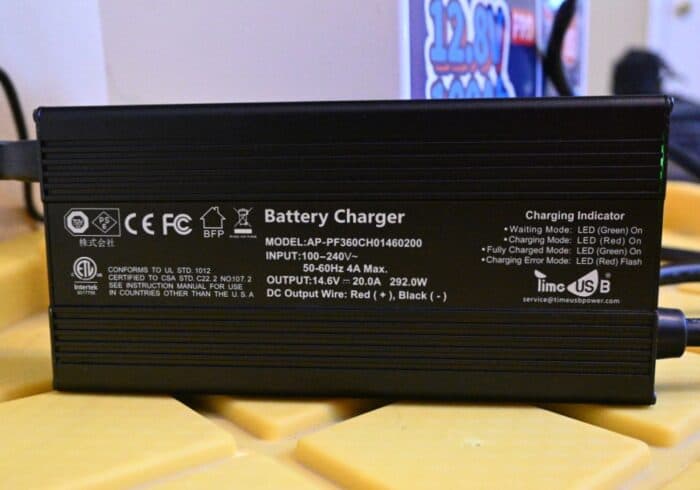
I tested the voltage output of the Timeusb battery charger while charging.
Since it’s a lithium battery charger, the voltage steadily increases. It got to 14.2 volt pretty quickly and then charged at 14.4 volts most of the time.
The voltage from the charger is correct for charging lithium batteries.
Timeusb advertises that the 20 amp charger can charge a 100 ah lithium battery in 5 hours.
The 5 hours comes from dividing 100 (amp hour capacity of battery) by 20 (the amp input of charger).
The lithium batteries I’ve been charging haven’t been below 50% discharge, but the charge times have been fairly accurate with the math.
It seems to take a little longer on certain batteries, but that could have more to do with the battery management system (BMS) in the battery.
See Also: How To Wire Multiple 12V Or 6V Batteries To An RV
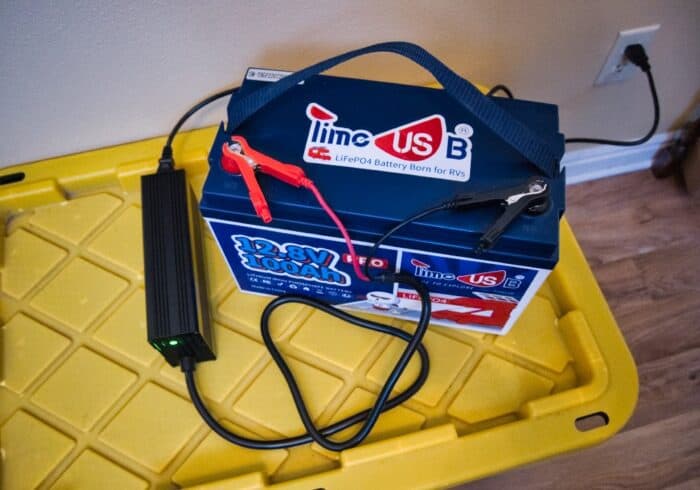
Timeusb 20 Amp Lithium Battery Charger Review
I’ve been using this simple LiFePO4 battery charger for a few weeks on 3 different brands of lithium-ion batteries.
So far, it’s had no problems charging them to 100% and the BMS (battery management system) in the batteries haven’t stopped the charger, which is a good sign that’s its charging correctly and safely.
The Timeusb is a very simple, budget lithium battery charger, but it works great.
It only has an LED light as an indicator, but it still has lots of safety features, a good inner fan, and a durable aluminum shell.
I would recommend it to anyone looking for a lithium specific charger to use regularly.
Like
- Easy to use
- 20 Amp Fast Charger
- Gets to the correct charging voltages for lithium batteries.
- Aluminum Shell
- LED Light Indicator
- Doesn’t Get Hot
- Easy to understand user manual.
- 5 Year Warrenty
Don’t Like
- Noisy Fan
- Short Power Cable
- Alligator clamps could be a little better quality.
Have questions about the Timeusb lithium battery charger? Leave a comment below.



Hello Time USB,
I recently purchased a new Timeusb 12V 100Ah Pro LiFePO4 Battery | 1.28kWh & 1.28kW | 100A BMS, I also purchaced a Timeusb 14.6V 20A Fast Charging LiFePO4 Battery Charger. I hooked up everything for the 1st charge, new right out of the original boxes, after about three hours the battery charger cycled from red LED light to green LED light every 2-3 seconds continually, you could hear the charge kicking on/off to the same tempo. My tester showed the charge input to be 14.7 amps cycling with the LED lights. Is my battery bad? Is my charger bad? Is this normal? The charger directions say that the green light should stay green when fully charged.
Hi Kenneth,
It’s hard to know if it’s the charger or the BMS system in the battery that’s causing the issue. It should have a green light when fully charged like you say.
You can contact Time USB customer on their website. They will probably be more help with troubleshooting, especially if it’s the battery that’s the problem.
…having just purchased a 50AH LIPo4 from you guys, I have one question: The battery will be used to power some Amateur Radio equipment, mainly a 100 watt HF transceiver. I have a Renogy 20 amp solar charger, and the attached 250 watt solar panel puts out maybe 16 amps on a good day… most of the time far less… this seems a good match. The Renogy seems to only have preset settings for lead acid based batteries… flooded, SLA or gel… Will the BMS act as a sort of charge controller or is it only for protection against over, or undercharging, should I be concerned?